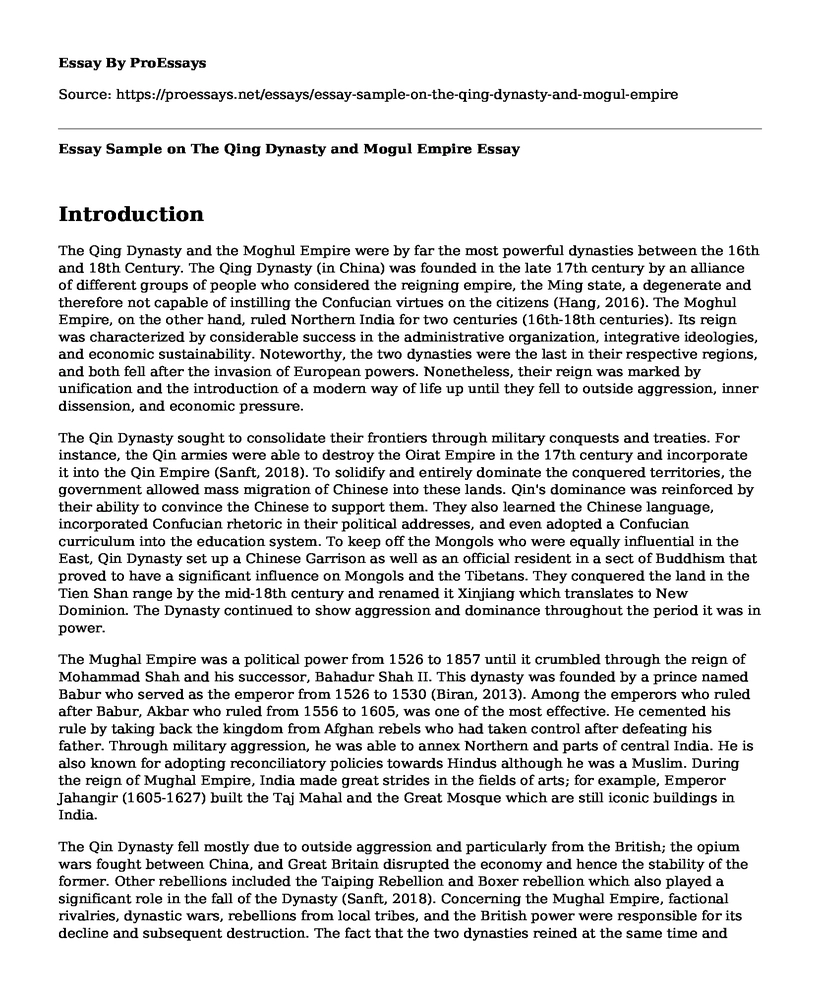Introduction
The Qing Dynasty and the Moghul Empire were by far the most powerful dynasties between the 16th and 18th Century. The Qing Dynasty (in China) was founded in the late 17th century by an alliance of different groups of people who considered the reigning empire, the Ming state, a degenerate and therefore not capable of instilling the Confucian virtues on the citizens (Hang, 2016). The Moghul Empire, on the other hand, ruled Northern India for two centuries (16th-18th centuries). Its reign was characterized by considerable success in the administrative organization, integrative ideologies, and economic sustainability. Noteworthy, the two dynasties were the last in their respective regions, and both fell after the invasion of European powers. Nonetheless, their reign was marked by unification and the introduction of a modern way of life up until they fell to outside aggression, inner dissension, and economic pressure.
The Qin Dynasty sought to consolidate their frontiers through military conquests and treaties. For instance, the Qin armies were able to destroy the Oirat Empire in the 17th century and incorporate it into the Qin Empire (Sanft, 2018). To solidify and entirely dominate the conquered territories, the government allowed mass migration of Chinese into these lands. Qin's dominance was reinforced by their ability to convince the Chinese to support them. They also learned the Chinese language, incorporated Confucian rhetoric in their political addresses, and even adopted a Confucian curriculum into the education system. To keep off the Mongols who were equally influential in the East, Qin Dynasty set up a Chinese Garrison as well as an official resident in a sect of Buddhism that proved to have a significant influence on Mongols and the Tibetans. They conquered the land in the Tien Shan range by the mid-18th century and renamed it Xinjiang which translates to New Dominion. The Dynasty continued to show aggression and dominance throughout the period it was in power.
The Mughal Empire was a political power from 1526 to 1857 until it crumbled through the reign of Mohammad Shah and his successor, Bahadur Shah II. This dynasty was founded by a prince named Babur who served as the emperor from 1526 to 1530 (Biran, 2013). Among the emperors who ruled after Babur, Akbar who ruled from 1556 to 1605, was one of the most effective. He cemented his rule by taking back the kingdom from Afghan rebels who had taken control after defeating his father. Through military aggression, he was able to annex Northern and parts of central India. He is also known for adopting reconciliatory policies towards Hindus although he was a Muslim. During the reign of Mughal Empire, India made great strides in the fields of arts; for example, Emperor Jahangir (1605-1627) built the Taj Mahal and the Great Mosque which are still iconic buildings in India.
The Qin Dynasty fell mostly due to outside aggression and particularly from the British; the opium wars fought between China, and Great Britain disrupted the economy and hence the stability of the former. Other rebellions included the Taiping Rebellion and Boxer rebellion which also played a significant role in the fall of the Dynasty (Sanft, 2018). Concerning the Mughal Empire, factional rivalries, dynastic wars, rebellions from local tribes, and the British power were responsible for its decline and subsequent destruction. The fact that the two dynasties reined at the same time and rarely engaged in warfare can be a lesson to the current political powers to strive to maintain peace and pursue development for the sake of the entire humanity.
References
Biran, M. (2013). The Mongol Empire in World History: The State of the Field. History Compass, 11(11), 1021-1033. doi:10.1111/hic3.12095
Hang, H. C. (2016). China, imperial: 8. Qing or Manchu dynasty period, 1636-1911. The Encyclopedia of Empire, 1-13. doi:10.1002/9781118455074.wbeoe287
Sanft, C. (2018). The Qin Dynasty. Routledge Handbook of Early Chinese History, 146-159. doi:10.4324/9781315773605-7
Cite this page
Essay Sample on The Qing Dynasty and Mogul Empire. (2022, Nov 21). Retrieved from https://proessays.net/essays/essay-sample-on-the-qing-dynasty-and-mogul-empire
If you are the original author of this essay and no longer wish to have it published on the ProEssays website, please click below to request its removal:
- A Letter to Bartolome de las Casas in Response to His Book
- The Cold War Summary Essay Example
- Compare and Contrast Essay on Osama Bin Laden vs. Anwar al-Awlaki
- Essay Example on Hector Lavoe: The Best Salsa Musician in History
- A Reflection of America's Cultures
- The Vietnam War: An Epic War of Resistance 1954-1973 - Essay Sample
- Paper Example on Truman's Potsdam Ultimatum: Japanese Surrender with Retention of Emperor







